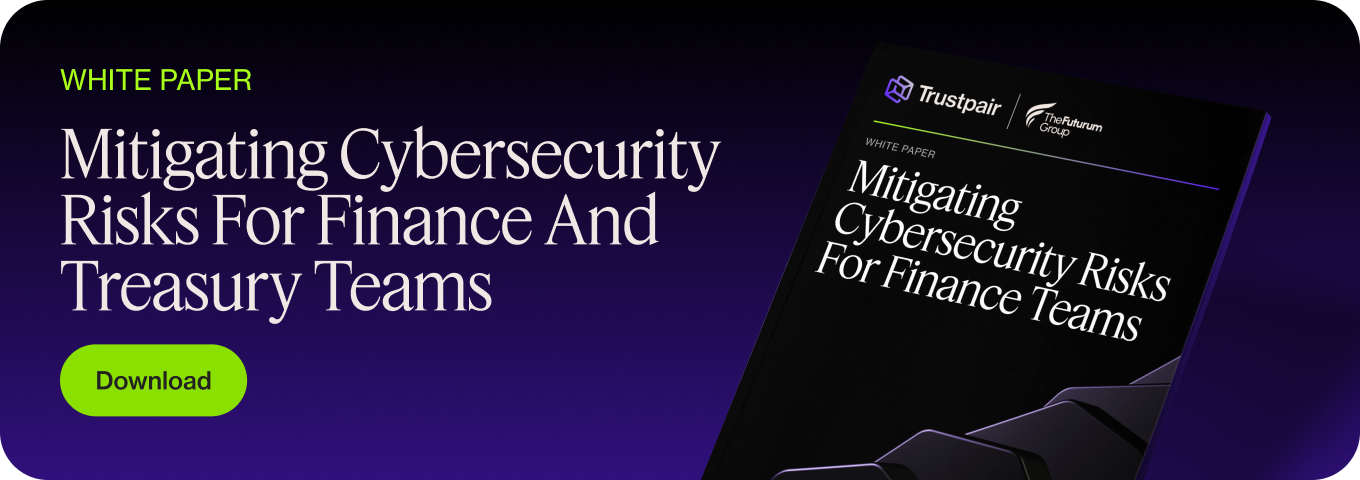It’s the second week of 2024 and we’ve already had a high-profile case of cyber fraud. The SEC’s X (Twitter) account was hacked and a ‘newly approved’ bitcoin ETF was promoted, causing a surge in the cryptocurrency price. Not only was this contradictory for the SEC, but it caused significant financial gains for the cybercriminals. Fraud scores are essential in highlighting risks, and enabling organizations to prevent these kinds of vulnerabilities. Learn how to calculate an IP fraud score, and protect your business.
Trustpair’s automated account validation blocks fraudsters from making suspicious payments, even if they penetrate your system. To learn more about cybersecurity risks and how to defend yourself against them, download our white paper!
What is the IP fraud score?
The IP fraud score is a number between 1-100. This scale represents the likelihood of fraud, based on several pre-determined components. The presence or absence of these components is each given a score and then totaled up. Every company has its threshold, but generally speaking, the lower the number, the lower the risk of fraud.
Components of the IP fraud score include risk factors like the IP address location, whether this matches the location of the third party, whether the address is residential and more. Fraud scoring is used to help companies detect attempts of fraud, and prevent both the financial losses and reputational damages associated with falling victim to fraud.
While the IP fraud score can’t be the sole reason to reject an order or new partnership with a supplier, it can signify that more information is needed before you sign on the dotted line.
Fraud scoring can be useful in any type of business, but it’s most commonly used in regulated industries like banking and insurance. E-commerce platforms also use the calculation to arm small business owners with the choice to serve a high-risk customer to prevent chargebacks.
How does IP screening enhance fraud detection?
IP screening plays an essential role in fraud detection by verifying if the IP address aligns with a user’s or third party’s expected location. This process is often included in fraud scoring models as it can detect potential red flags such as mismatches between the IP location and billing address, use of VPNs, or other suspicious activity.
Why is the IP fraud score important?
IP fraud scoring is an integral tool for any business that wants to prevent losses through fraud. Generally speaking, a high fraud score can indicate a greater risk of fraud (although there are false positives to watch out for!).
Protect against cyber risks
In particular, IP fraud scores are important as they form part of the overall cyber risk assessment. This essentially involves identifying, assessing, and responding to cyber risks, and using the information to inform the direction of company decisions.
Cyber risks can include:
- Malware attacks
- Phishing scams
- Pharming violations
- Social engineering hacks
- Ransomware fraud
Therefore, by understanding the risk factors, companies can calculate the likelihood of each type of cyber risk occurring. Moreover, by identifying these types of attacks, organizations can actively work to plug any vulnerabilities and create a strong strategy against fraud.
The fraud score is just one part of this strategy. For example, using fraud scoring to risk assess a potential new vendor could block suspicious parties. Thus, the procurement team should know to treat emails with links very carefully from such parties, protecting the business from pharming.
Real-time action
Fraud scoring enables businesses to respond to real-time threats and make decisions via automated rules.
Fraud scoring typically works through automated software platforms, which means that the score itself can be calculated instantly, as the third party is still on the line.
This can be incredibly useful since it enables organizations to set behavior-based rules. For example, if the fraud score is above 89, you could automatically set your software to reject an order. This translates to a high-risk individual (likely a cybercriminal) blocked from attempting to make a purchase and defraud the business through a chargeback.
Fortunately, this also works for third-party partnerships, in the form of SOPs or guides. When the fraud score is high, procurement employees can raise their queries with their managers about the level of risk. This might result in outright rejection, or trigger a deeper investigation.
Verify customers and partners
In this day and age, customers have grown to appreciate the extra security measures that signal when a business can keep their information safe and secure. Thus, although fraud scoring might result in slightly more friction during the sales process, the benefits usually outweigh the cons.
Since a fraud score works in both b2b and b2c settings (preventing fraudulent customers from submitting false chargebacks, for example), it’s a versatile tool in protecting your business. And where social engineering techniques are involved (ie. those manipulating the humans in the business), fraud scores can help verify customers and partners based on unemotional evidence.
How do you calculate a fraud score?
Every company has its own algorithm for fraud score calculations, which means there’s no set method. However, most IP fraud scores are calculated by assessing the following factors:
- Billing and shipping match: simply, does the billing address match the shipping address?
- Bank and billing match: does the bank location (country or state) match the billing address?
- IP address and billing match: is the computer being used to make the purchase in the vicinity of the billing address?
- Proxy detection: is there a VPN in use? Any attempts to conceal or change location will be treated suspiciously and could signify a pharming attack
- Email age: the older the email account, the more credible
Fraud scoring models
Most companies opt for fraud scoring models in order to automate the process of fraud detection.
This works by weighting each of the factors against one another, according to relevance and potential consequences. For example, proxy detection might make up 30% of the overall risk score, whereas billing and shipping match may only make up 10%.
Here is what each score could signal within the model:
- 0-10: very low risk of fraud – there is a high level of confidence in the purchaser’s identity, and zero history of fraudulent or suspicious behavior
- 11-49: low risk of fraud – there are some indications that the party is who they say they are, and that their purchase is genuine
- 50-69: neutral risk – there is nothing to indicate confidence either way and without this guidance, there is a medium level of fraud risk
- 70-89: high risk of fraud – there are signals of deception or mismatching information which increase the risk (although at this stage everything must be verified as there is also a chance of false positives)
- 90-100: very high risk of fraud – strong signals of deception and mismatched information, history of fraud connected to this account, and a high likelihood of cybercrime
By using an automated fraud scoring system for customers, businesses are effectively trying to protect themselves from false chargebacks. However, where an IP fraud scoring system has been used, businesses have little recourse if they do then fall victim to a scam.
Therefore, it’s important to ensure that the chosen fraud scoring model is credible, with low percentages of false positives and high confidence. Otherwise, businesses would not only put themselves at risk of fraud but also risk losing revenue by turning down genuine paying customers, or legitimate suppliers.
Block the effects of cyber-fraud with prevention software
Cyber fraud presents a real threat to businesses in any industry since penetration by fraudsters could reveal company secrets, publish sensitive information, and cause financial losses.
However, fraud detection and prevention software can help. Trustpair’s platform protects companies against payment fraud by using a combination of tools, including fraud scoring. This is paired with reliable global vendor data, automated account validations, and cross-functional workflows to pack a punch against fraud attempts.
Choose Trustpair to block the financial effects of cyber-fraudsters. Request a demo now!
Summary:
The fraud score automatically gathers data in various categories to calculate the risk of fraud. Then, custom rules will determine the response plan – whether to go ahead with any sales or block a likely fraudster. Fraud detection and prevention platforms like Trustpair use fraud risk scoring under their machine learning programs, to protect companies.






